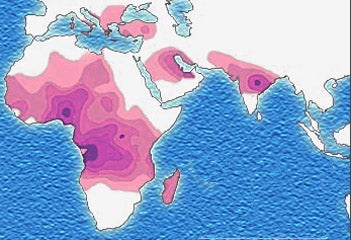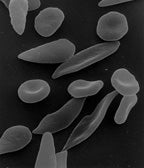| |
Chronic Anemia, meaning long term continuous instances, is normally the result of inherited genetic traits. While most often genetic, recurring anemia can also result from other long term health problems. The genetic explanations of chronic anemia are very complex, so I will only provide brief explanations for some of the more common genetic causes. These genetic disorders are as of now are largely incurable (meaning they cannot be avoided or fixed), although certain procedures can potentially relieve symptoms and prolong life.
Examples of genetic forms of anemia are:
-
Fanconi anemia - A rare genetic disorder found in every ethnicity and both genders. The disease causes numerous health problems, particularly a failure to develop bone marrow and severe risks of leukemia. It can be diagnosed during the first trimester of pregnancy. Though found in every population, research shows the genes are most common in people of Ashkenazi Jewish heritage.
-
Sickle-Cell anemia - Is caused by a genetic condition (Sickle-Cell disease) most commonly found in men and women of Sub-Saharan African descent, but also people with lineage from areas shown below. Anemia is just one system of the disorder, which generally causes various chronic pains as well. The cause is a genetic mutation which alters the shape and size of red blood cells, specifically cells are longer and curved (like a sickle). The irregular blood cells can restrict the flow of oxygen through blood vessels causing severe anemia and potentially strokes (especially in young children). The hemoglobin levels in people with sickle-cell disease is usually at critically low levels, the most critical period is childhood when levels average 7g/dl (recalling that 11.1 g/dl is the cut of line for healthy). Low hemoglobin levels persist throughout life, rarely reaching over 10 g/dl and sometimes dropping below 6 g/dl (less than half the anemia cut-off line for adults of either gender. People with Sickle-Cell disease have a greatly reduced life expectancy (generally placed around 45-50 years), in part, because the greatest risk of death occurs before the age of 12.

-
Diamond-Blackfan anemia - the exact cause of Diamond-Blackfan anemia is still subject to research. It is, at least, partly inherited as about a quarter of new cases have a family history. That number may seem low, but the disease was first identified in 1938, and the gene involved is believe to be rare and recessive (like Sickle-Cell and Fanconi), meaning that, even if both parents carry the gene, a child has a 25% chance of developing the disorder. No singular gene has been identified as the cause, but the resulting effect is a failure of blood cells to fully form and lack of bone marrow development.
-
Hereditary Spherocytosis anemia - A genetic trait found mainly in people of Northern European ancestry, but also found in Japan and small pockets pockets of Northern Asia. Like Sickle-cell it causes a mutation of red blood cells, but in Sperocytosis the shape is spherical and usually smaller than normal. The main risk of life threatening Spherocytosis occurs along side major illness, when protein deficiencies and decrease blood-oxygen may result in decreased heart and liver function.
Example of red blood cells in a person with Sickle-Cell disease

Many people who feel they are likely carrier of these genes, based on family history, consult doctors and/or genetic counselors to discuss possible illnesses/defects, prior to attempting pregnancy. It is personal choice that each couple must make on their own, but it is an option that people may wish to consider.
Continued research is being conducted on advanced treatments and potentially cures for genetic based chronic anemia. The Human Genome Project has greatly improved doctors' understanding of the specific genetic causes. I do not wish to use this page to promote any organizations, but information on groups supporting such research are provided in the links section for those interested in learning more.
|